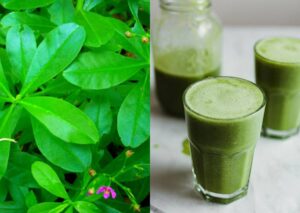Waterleaf (Talinum triangulare) is a leafy green vegetable commonly found in tropical and subtropical regions, particularly in West Africa and parts of Asia.
It is known by various names, including “edible amaranth,” “surinam purslane,” “Florida spinach,” and “Ceylon spinach.” Waterleaf is popular in traditional cuisines and has various culinary uses.
Characteristics of Waterleaf
- Appearance: Waterleaf plants have tender, green leaves with a slightly succulent texture. The leaves are typically lance-shaped or triangular, and they may be slightly serrated along the edges.
- Growth: Waterleaf is an annual plant that grows well in moist, well-drained soil. It can be found in gardens, fields, and in the wild.
- Taste: Waterleaf has a mild, slightly tangy taste, similar to spinach or other leafy greens. It can be eaten raw or cooked.

Culinary Uses
Waterleaf is a versatile leafy green with a variety of culinary applications, especially in West African cuisine. Here are some common ways waterleaf is used:
- Soups and Stews: Waterleaf is frequently used as an ingredient in soups and stews. It is added to dishes like “egusi soup” and “efo riro” to enhance flavor and nutritional content.
- Salads: In some regions, waterleaf is used raw in salads, often mixed with other vegetables and ingredients.
- Smoothies: Waterleaf can be blended into green smoothies along with fruits and other vegetables for added nutrition.
- Sautéed or Stir-Fried: Waterleaf can be lightly sautéed or stir-fried with onions, garlic, and spices as a simple side dish.
Nutritional Benefits
Waterleaf is valued not only for its culinary versatility but also for its nutritional benefits:
- Rich in Vitamins and Minerals: It is a good source of vitamins such as vitamin C, vitamin A, and vitamin K. It also provides essential minerals like calcium, potassium, and iron.
- Low in Calories: Waterleaf is low in calories, making it a suitable addition to a low-calorie diet.
- Dietary Fiber: It contains dietary fiber, which aids in digestion and helps maintain a feeling of fullness.
- Antioxidants: Waterleaf contains antioxidants that can help protect cells from oxidative damage.
Cultural Significance
Waterleaf holds cultural significance in West African cuisines, where it is a staple ingredient in many traditional dishes. It is particularly popular in Nigeria, where it is used in a wide range of soups and stews. In Nigerian markets, fresh waterleaf is widely available, and it is commonly grown in home gardens.
In some cultures, waterleaf is associated with vitality and health due to its nutritional content. It is often included in dishes prepared for special occasions, family gatherings, and festivals.
Challenges
One challenge associated with waterleaf is its perishability. It tends to wilt quickly after harvesting, which makes it important to use fresh waterleaf soon after picking or purchasing. In some cases, people resort to drying and preserving it for later use.
In summary, waterleaf is a nutritious leafy green vegetable commonly used in West African cuisine. It is appreciated for its mild flavor, versatility in cooking, and health benefits. Whether added to soups, salads, or stir-fried as a side dish, waterleaf plays a valuable role in culinary traditions and diets in many regions.










